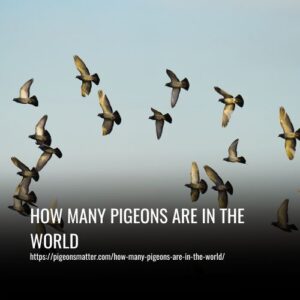No, pigeons are not native to North America. They were introduced to the continent in the early 1600s. Pigeons are commonly seen in urban areas worldwide and their presence in cities is due to the similarity between city buildings and the rocky cliffs that their ancestors in Europe originally inhabited.

Where Did Pigeons Come From
Rock doves, also known as pigeons, have a fascinating history with humans. Originally found in southern Europe, north Africa, the Middle East, and western and central Asia, they were consumed for food by both Neanderthals and Homo sapiens. The species was domesticated by humans around 4,500 BC for use as a food source.
As humans discovered the pigeons’ navigational abilities, they started using them for various purposes. Pigeons captured and released hundreds of miles away from their coops would fly back home, demonstrating a remarkable homing instinct. This behavior allowed humans to use pigeons to guide sailors towards land and deliver messages over long distances. Messenger pigeons played a crucial role in WWI and WWII, helping send messages from the front lines and even saving stranded troops.
Over time, however, chickens became the preferred bird for meat consumption, and pigeon breeding shifted from food production to a hobby activity. Pigeon enthusiasts created numerous breeds with unique plumage and colors, giving rise to breeds like the Arabian Trumpeter, Fairy Swallow, and Danish Jacobin.
Even Charles Darwin, known for his work on evolution, studied and bred domestic pigeons. Their intricate breeding patterns provided valuable insights and helped shape Darwin’s ideas on evolution. While Galapagos finches are often associated with Darwin’s work, domestic pigeons also played a significant role in his research.
Why Are Pigeons Everywhere
Feral pigeons have successfully colonized every continent except Antarctica due to the actions of humans. European colonists brought domestic pigeons to the Americas in the 17th century, leading to the establishment of feral populations. Similar introductions occurred in Australia in the 1870s. Unlike their wild counterparts, feral pigeons have adapted to live alongside humans in urban and agricultural areas.
They rely on human-created habitats and food sources and rarely move far from human settlements. Despite being often disliked and considered a nuisance, the abundance of feral pigeons is a result of human influence on their environment.
Pigeons Of North America
North America is home to seven species of native pigeons, with the most common being the mourning dove. Owing to their pleasant vocalizations, these birds are named after their soulful cooing. Although migratory in Northern regions, suburban birds can survive winters in warmer regions provided they have consistent access to food sources.
The other native pigeon species have a relatively southern distribution, with the band-tailed pigeon, white-winged dove, and ground dove being found in the Southwest and Southeast. The white-crowned pigeon is limited to the Florida Keys and some surrounding regions in mainland North America for observation.
While hunting for sport may be practiced wherever these birds are abundant, overhunting has driven the passenger pigeon to extinction, which was once a common bird, sold in urban markets.
FAQs
Feral pigeons are typically dark gray or brownish with white patches on their wings and heads and have iridescent feathers on their necks and chests. They have short beaks and rounded bodies with long wings.
Feral pigeons usually inhabit cities and other built-up areas, although they sometimes breed in more natural habitats as well.
Feral pigeons can be a nuisance when abundant, soiling statues and buildings with their excrement, and sometimes fouling people walking along streets or in parks.
Conclusion
This article sheds light on the question- are pigeons native to North America or not? Through extensive research, it has been established that while there are several pigeon species found in North America, none of them are truly native to the continent. By providing this information, the article can help readers understand the history and evolution of pigeon populations in North America.
Additionally, readers will gain a better understanding of the impact that introduced species, such as feral pigeons, have had on the ecosystem. Overall, this article serves as a valuable resource for those interested in pigeon species and their impact on North America.


